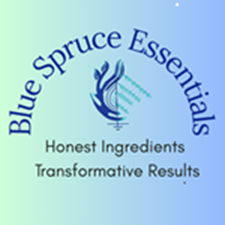
Pigmentation vs. Dark Spots: What’s the Difference And Why It Matters for Skin Over 40
Share
Let’s be honest, turning 40 is a significant milestone. But while we’re getting wiser and stronger, our skin might start telling a different story: dark patches, uneven tone, and stubborn spots that won’t fade. Sound familiar?
But here’s the thing: not all spots are the same. There’s pigmentation, there are dark spots, and there are actual differences between the two, especially if you’re dealing with mature skin.
Let’s break it all down in a way that makes sense.
In this article, we’ll explore:
- What pigmentation and dark spots are
- Why mature skin develops dark spots
- Common types of pigmentation after 40
- Science-backed treatments for dark spots and pigmentation
- How Blue Spruce Essentials’ ingredients work to combat these concerns

Pigmentation vs. Dark Spots: What’s the Difference?
Pigmentation is an umbrella term; it refers to color in your skin. When your skin begins to produce more than a normal quantity of melanin (the pigment that gives skin its color), you may start to notice patches, spots, or widespread dullness.
Dark spots are pigmentation, typically resulting from something such as sun exposure, acne scarring, or hormonal imbalances. Consider them as being very much like melanin "freckles" that linger longer than we would prefer.
In a nutshell, all dark spots are pigmentation, but not all pigmentation is just dark spots.
Why Does Skin Over 40 Start Showing These?
With age, our skin's natural repair mechanism slows. Throw in a few years of sun damage, pollution, hormonal changes, and perhaps a few late nights, and boom, melanin begins going crazy.
- Sunlight also increases the amount of melanin, particularly in parts such as the cheeks, forehead, and hands
- Hormonal changes (hi, perimenopause!) may cause a condition known as melasma, mottled pigmentation that is difficult to correct
- Loss of skin barrier function can lead to inflammation, which stimulates melanin production
- Decline in cell turnover means older pigmented cells linger longer
Common Types of Pigmentation in Your 40s
- Age Spots (Liver Spots): Flat brown dots from years of sun exposure
- Melasma: Large, symmetrical patches (often on the cheeks or forehead), usually hormonal
- Post-Inflammatory Hyperpigmentation (PIH): Spots left after acne, eczema, or irritation
- Freckles: Usually harmless but may become darker with age and sun
What Science Says: Ingredients That Work
You don’t need a 10-step routine or harsh peels to get brighter skin, just ingredients that work.
Here’s what science (and Blue Spruce Essentials) is bringing to the table:
Kojic Acid
Made during the fermentation of rice and sake, this natural acid blocks tyrosine, the amino acid needed to make melanin.
✅ Clinically backed to fade pigmentation and melasma
✅ Gentler alternative to hydroquinone
A 2013 review found that Kojic Acid at concentrations under 1% can significantly lighten dark patches without irritation. (Source: NCBI)
Niacinamide (Vitamin B3)
A total multitasker that tackles dullness, fine lines, and pigmentation.
✅ Reduces melanin transfer to the skin surface
✅ Improves skin barrier so dark spots fade faster
In a study published in the British Journal of Dermatology, 5% niacinamide was shown to visibly reduce hyperpigmentation in just 4 weeks.
Pomegranate Seed Oil
This underrated oil is rich in punicic acid and polyphenols — powerful antioxidants that protect and repair aging skin.
✅ Promotes cell regeneration and collagen production
✅ Fades pigmentation caused by oxidative stress
According to the Journal of Ethnopharmacology, pomegranate extract shows measurable improvement in skin brightening and elasticity.
Honey
Honey is more than a humectant, it’s packed with bioactive compounds such as flavonoids and phenolic acids, known for powerful antioxidant and anti-inflammatory effects. Analyses show that darker honeys often exhibit higher levels of these compounds, contributing to their ability to neutralize oxidative stress and protect skin functions ScienceDirectMDPI. Honey also supports skin barrier repair and has antimicrobial properties, helping to soothe and reinforce your skin’s natural defenses.
Rice Bran Oil
Rice bran oil is enriched with γ-oryzanol, tocopherols, and phytosterols, all potent antioxidants. γ-Oryzanol, specifically, helps reduce inflammation and support the skin’s protective barrier MDPI+10Journal of Chemical Health Risks+10Wikipedia+10. Laboratory studies show improved hydration, barrier integrity, and UV resistance when using rice bran oil, making it a standout botanical ally for mature skin.
Green Tea (EGCG)
EGCG (Epigallocatechin gallate), the star compound in green tea, has been shown to effectively inhibit tyrosinase, the enzyme that initiates melanin synthesis, thereby helping fade pigmentation Wikipedia+6Journal of Chemical Health Risks+6PMC+6. Additionally, EGCG suppresses collagenase and elastase enzymes that degrade skin structure, offering anti-aging benefits alongside pigment control ResearchGate+4PMC+4MDPI+4.
Babchi & Rosehip Oils
✅Babchi oil contains bakuchiol, a botanical analog of retinol, prized for promoting collagen synthesis and evening skin tone without irritation—ideal for sensitive, mature skin.
✅Rosehip oil is rich in natural retinoic acid, linoleic acid, and Vitamin C, supporting cell turnover, brightening, and barrier repair with antioxidant protection.
Combined synergy of babchi’s retinoid-like effects with rosehip’s reparative nutrients offers a gentle yet effective pro-aging duo, brightening and reinforcing skin resilience.
This is where Blue Spruce Essentials comes in: our Barrier Boost & Kojic Kiss pair these clinical actives with cold-pressed botanicals to deliver results, without irritation.
How to Treat Pigmentation at Home (Without a Lab Coat)
There’s a smart way to treat pigmentation naturally:
- Wear SPF daily, no negotiation here
- Use a brightening cream at night with kojic acid + niacinamide (like Kojic Kiss from Blue Spruce Essentials)
- Layer with oils rich in antioxidants, almond, pomegranate, and jojoba, which calm inflammation, moisturize, and reduce free radical damage
-
Be patient, real change happens slowly. Gentle, consistent care always beats quick fixes.
At Blue Spruce Essentials...
We’ve packed our two creams, Barrier Boost and Kojic Kiss, with the goodness of:
- Niacinamide, for a smoother, brighter tone
- Kojic Acid, to gently lighten stubborn spots
- Pomegranate & Jojoba Oils, to nourish and protect
- And Honey & Aloe Vera for soothing hydration and added glow
These aren’t just fancy buzzwords; they’re backed by real science and formulated for real skin over 40.
Final Thoughts
You don’t need filters or harsh peels to feel good in your skin. Instead, you need to treat your skin with clean, proven ingredients that love it back.
So next time you look in the mirror and notice a new spot, don’t panic. Get curious, get informed, and give your skin the support it deserves.
Because aging is a privilege, and great skincare is your reward.
✨ Ready to support your skin, your way?
Explore our pro-aging essentials at Blue Spruce Essentials, where science meets self-care.
FAQs
1. What is the difference between pigmentation and dark spots?
Pigmentation is the process of melanin production that gives skin its color. Dark spots are a localized form of hyperpigmentation—excess melanin clumps from triggers like UV, aging, or inflammation.
2. Why do dark spots become more common after 40?
After 40, collagen declines (~1%/year), cell turnover slows (~28 days → 45+), and hormonal shifts reduce melanin regulation—so spots form more easily and fade more slowly.
3. Can pigmentation and dark spots be treated the same way?
They overlap but aren’t identical. General tone issues need ongoing melanin balancing; dark spots respond well to targeted actives (kojic acid, niacinamide, alpha arbutin) + daily SPF.
4. Which ingredients help fade pigmentation and dark spots?
Actives: Niacinamide (4–6%), Kojic Acid (1–2%), Alpha Arbutin (2%).
Natural antioxidants: Rice bran oil (γ-oryzanol), honey (flavonoids), green tea (EGCG), rosehip, babchi.
Always pair with SPF 30+.
5. Can lifestyle help reduce pigmentation?
Yes—daily sunscreen (even indoors), antioxidant-rich diet (berries, leafy greens, pomegranate), sleep consistency, and lower sugar intake support healthier melanin regulation.
6. Do I have melasma or pigmentation?
Melasma is a specific type of pigmentation triggered by hormonal changes (pregnancy, menopause, contraceptives) and worsened by sun exposure. It usually appears as symmetrical brown-gray patches across cheeks, forehead, or upper lip.
General pigmentation includes all forms of uneven melanin production—dark spots, freckles, post-inflammatory marks. If your patches are symmetrical and mask-like, it may be melasma. For an accurate diagnosis, a dermatologist consultation is recommended.
7. How to treat melasma during pregnancy?
During pregnancy, only safe and gentle options should be used. Avoid hydroquinone, retinoids, and high-strength chemical actives as they are not recommended in pregnancy.
Instead, focus on:
- Daily broad-spectrum SPF 30–50 (mineral sunscreens with zinc oxide or titanium dioxide are safest).
- Gentle brighteners like niacinamide or azelaic acid (pregnancy-safe).
- Barrier-supporting oils such as jojoba, rosehip, and rice bran oil.
- Antioxidants like green tea or vitamin E to reduce oxidative stress.
Most pregnancy-related melasma (also called “the mask of pregnancy”) fades gradually after delivery, though maintenance with SPF is key to prevent worsening.
8. Is melasma related to the liver?
Melasma is not directly caused by liver problems. It is primarily triggered by hormonal changes, sun exposure, and genetic factors that affect melanin regulation.
That said, in alternative medicine, liver health is sometimes linked to skin clarity because the liver helps detoxify the body. Poor liver function can worsen oxidative stress, which may aggravate pigmentation indirectly.
In conventional dermatology, melasma is considered a skin condition related to hormones and UV exposure, not a liver disease. If you suspect liver issues, it’s important to consult a healthcare provider, but melasma itself is not classified as a liver-related disorder.
9. Is kojic acid good for melasma?
Yes, kojic acid is widely recommended for melasma. It works by inhibiting tyrosinase, the enzyme responsible for melanin production. By slowing down excess melanin synthesis, kojic acid helps lighten brown-gray patches associated with melasma over time.
Clinical studies show that topical kojic acid (1–2%) is effective in reducing melasma when used consistently, especially in combination with sunscreen and other brighteners like niacinamide or alpha arbutin.
Note: Melasma is often stubborn and recurrent. Results with kojic acid are gradual and require patience, daily SPF, and gentle skin care. For persistent cases, dermatologists may combine kojic acid with professional treatments (like chemical peels or laser therapy).
10. Which food decreases melanin in skin?
Some foods contain antioxidants and natural compounds that help regulate excess melanin production and improve skin tone. While diet alone cannot “erase” pigmentation, these foods support the skin’s defense against oxidative stress and UV damage:
- Tomatoes & Carrots → rich in lycopene and beta-carotene, which help protect against UV-induced melanin overproduction.
- Berries (blueberries, strawberries, blackberries) → packed with anthocyanins and vitamin C, which reduce free radicals that stimulate melanocytes.
- Pomegranate → high in ellagic acid, clinically shown to reduce UV-induced pigmentation.
- Leafy greens (spinach, kale) → contain lutein and vitamin C, antioxidants that protect against oxidative stress in skin cells.
- Green tea → its polyphenol EGCG inhibits tyrosinase activity, reducing excess melanin synthesis.
- Citrus fruits (oranges, lemons, kiwi) → vitamin C boosts skin repair and interferes with melanin pathways.
💡 Tip: Combine a nutrient-rich diet with daily SPF and topical actives (kojic acid, niacinamide, alpha arbutin) for noticeable results.
